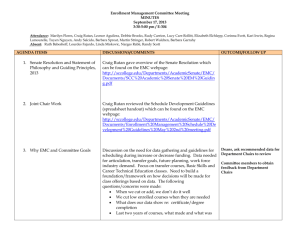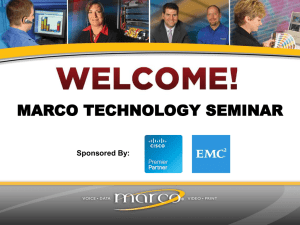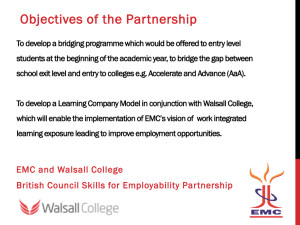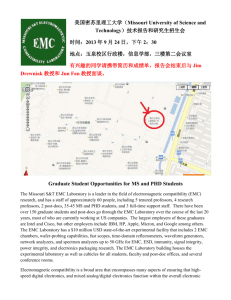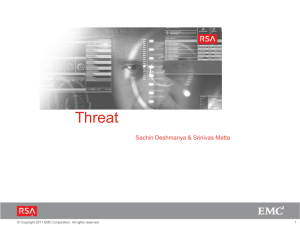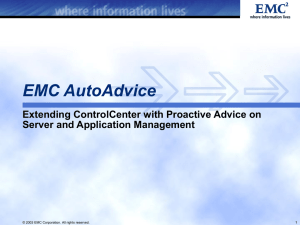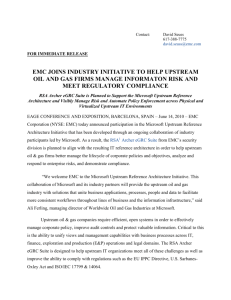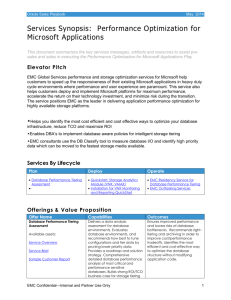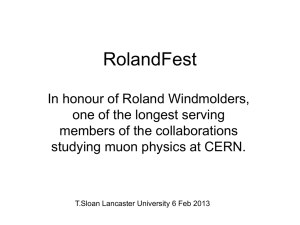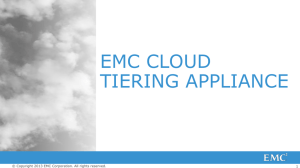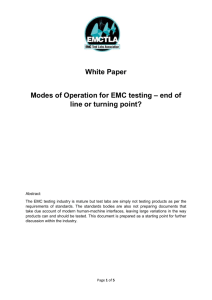Quality Management
advertisement
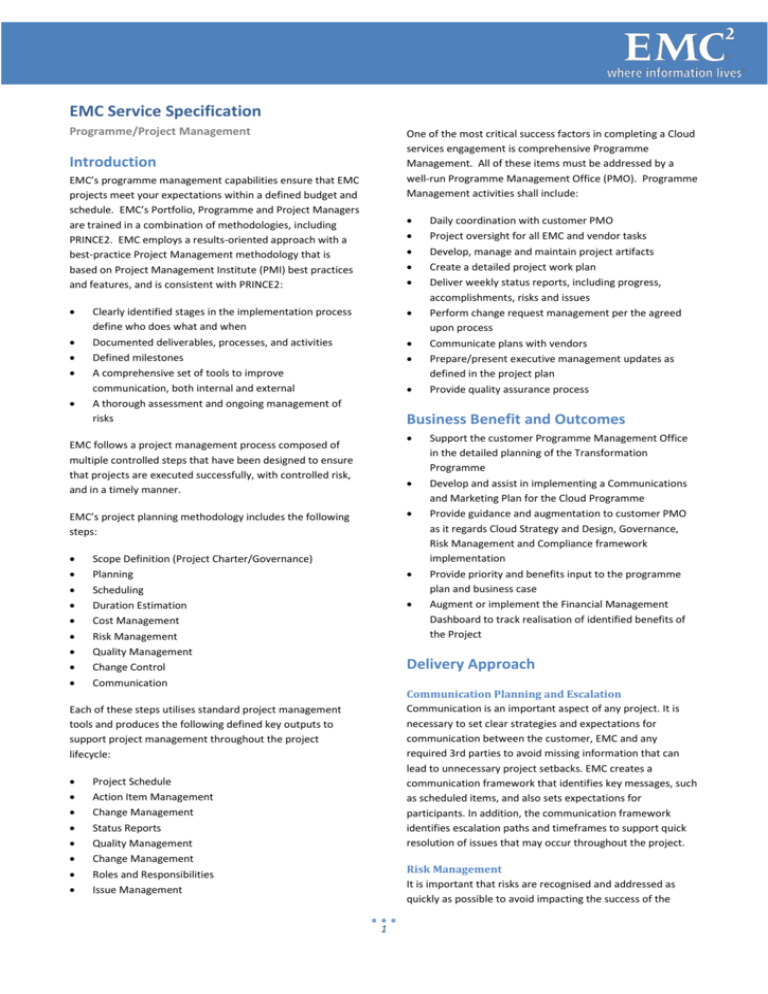
EMC Service Specification Programme/Project Management One of the most critical success factors in completing a Cloud services engagement is comprehensive Programme Management. All of these items must be addressed by a well-run Programme Management Office (PMO). Programme Management activities shall include: Introduction EMC’s programme management capabilities ensure that EMC projects meet your expectations within a defined budget and schedule. EMC’s Portfolio, Programme and Project Managers are trained in a combination of methodologies, including PRINCE2. EMC employs a results-oriented approach with a best-practice Project Management methodology that is based on Project Management Institute (PMI) best practices and features, and is consistent with PRINCE2: Clearly identified stages in the implementation process define who does what and when Documented deliverables, processes, and activities Defined milestones A comprehensive set of tools to improve communication, both internal and external A thorough assessment and ongoing management of risks Business Benefit and Outcomes EMC follows a project management process composed of multiple controlled steps that have been designed to ensure that projects are executed successfully, with controlled risk, and in a timely manner. EMC’s project planning methodology includes the following steps: Scope Definition (Project Charter/Governance) Planning Scheduling Duration Estimation Cost Management Risk Management Quality Management Change Control Communication Support the customer Programme Management Office in the detailed planning of the Transformation Programme Develop and assist in implementing a Communications and Marketing Plan for the Cloud Programme Provide guidance and augmentation to customer PMO as it regards Cloud Strategy and Design, Governance, Risk Management and Compliance framework implementation Provide priority and benefits input to the programme plan and business case Augment or implement the Financial Management Dashboard to track realisation of identified benefits of the Project Delivery Approach Communication Planning and Escalation Communication is an important aspect of any project. It is necessary to set clear strategies and expectations for communication between the customer, EMC and any required 3rd parties to avoid missing information that can lead to unnecessary project setbacks. EMC creates a communication framework that identifies key messages, such as scheduled items, and also sets expectations for participants. In addition, the communication framework identifies escalation paths and timeframes to support quick resolution of issues that may occur throughout the project. Each of these steps utilises standard project management tools and produces the following defined key outputs to support project management throughout the project lifecycle: Daily coordination with customer PMO Project oversight for all EMC and vendor tasks Develop, manage and maintain project artifacts Create a detailed project work plan Deliver weekly status reports, including progress, accomplishments, risks and issues Perform change request management per the agreed upon process Communicate plans with vendors Prepare/present executive management updates as defined in the project plan Provide quality assurance process Project Schedule Action Item Management Change Management Status Reports Quality Management Change Management Roles and Responsibilities Issue Management Risk Management It is important that risks are recognised and addressed as quickly as possible to avoid impacting the success of the 1 project. EMC prepares an “agreed upon” process for identifying, documenting and mitigating risks that are specific to a project. This process becomes an integral part of the ongoing management of the project. The key activities and associated deliverables include, but are not limited to: Quality Management EMC continues to maintain consistent project quality and success through the strong implementation of Quality Assurance phases built into the project schedule. These phases set aside specific resources from the EMC organisation to perform on-site assessments of the team’s adherence to EMC’s processes, project methodology, and cloud services methodology. The documented results of these reviews are provided to both EMC and customer to enable adjustments and to keep the project operating within expected parameters. Project Charter Project Scope Project Objectives Project Governance Reporting Structure Stakeholders Roles and Responsibilities Resource Management Assumptions Critical Interdependencies Milestones and Deliverables Quality Management Communication Plan Engagement Communication Guidelines Communication Vehicles Escalation Process Risk Management Issues Management Action Items Project and Programme Status Reports Change Management Feedback Measuring Communication Success Scope Goals and Objectives Expectations PM Work Product Description Change Management The governance model defines the change management process that will be utilised by customer and EMC to document and manage changes that occur. This may include changes in scheduling, pricing, or scope. Roles and Responsibilities As part of the communication process, EMC clearly documents the roles and responsibilities of customer, EMC, and any required 3rd parties to alleviate confusion and ensure the project has the appropriate resources allocated to it. Roles and Responsibilities documentation identifies the different skill sets required as well as the responsible party that will be fulfilling them. Expectations Matrix Issue Management EMC Consulting has a process to track, manage, and resolve issues that occur during the project. This eliminates the obstacles that uncertainty and doubt can create by clearly showing issues, tracking them, and communicating how they are being resolved. Issues are detailed in the governance model. These groups address the following: Project Work Plan Key Deliverable Matrix Deliverable by phase Content of deliverable Criteria Acceptance Date Project Status Report Action Item Register Issues Register Risk Register Contact List Metric Dashboard Overall project management responsibility Recognising and managing interdependencies across customer organisations impacted by but not directly associated with the Migration Project Providing clear and accurate communications to internal and external stakeholders Providing effective and timely decision-making using a structured escalation process 2 Tasks Dependencies Outputs Resources Timeframes Milestones PM Work Product Description Quality Assurance Process Quality Assurance Workflow for Deliverables Quality Assurance Report Report outlining the findings and action items related to a Quality Assurance Review. Customer Pre-requisites Pricing is based on engagement scope, which is primarily dictated by: Size of organisation Number of Locations Number of Users Data-centre locations Technologies in use covering: Key business or organisation applications Productivity tools Infrastructure Networking Operating Systems Virtualisation Level of Virtualisation achieved and planned Management Tools in use Number and level of staff in IT Maturity of the IT organisation Third party providers and their contractual impact Pricing Pricing information can be found in the associated GCloud IV day rate cards spreadsheet. Information Assurance EMC does not require and will not accept access to customer data as part of this service and hence there are no Data Protection responsibilities relating to the provision of this service. EMC UK and Ireland holds an ISO 27001 certificate. For related services we work with a number of public sector accredited partners (for example Skyscape) Version Information V5-0 Last Updated: 20th September 2013 3
